Objectives
- Review the history of the disability rights movement in the United States.
- Examine levels of access through a social justice lens.
- Explore ways to move forward toward the vision of the disability rights movement.
Estimated Time
- Introduction – 5 minutes
- Presentation – Early Disability Rights Movement – 5 minutes
- Power of 504 Segment – 5 minutes
- Presentation – Leading to the Passage of the ADA – 5 minutes
- Signing of the ADA Video – 10 minutes
- Discussion – Segregation and “Separate but Equal” – 5 minutes
- Presentation – Examples of Lack of Access – 10 minutes
- Discussion – Creating a world that values access as a civil right – 10 minutes
- Closing – 5 minutes
Materials Needed
- Computer, LCD Projector, and speakers/audio connection
- Speakers or Audio Connection for Video
- Video: The Power of 504
Or Audio described version - Video: The Americans with Disabilities Act, Signing Ceremony, July 26, 1990
- Slides: Access as a Civil Right PowerPoint Slides: Download Here (PPT)
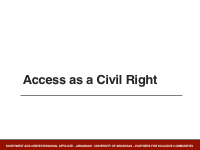
![]() Bring up title slide
Bring up title slide
![]() Welcome, everyone. [Introductions as appropriate.] Our focus today is on access and the civil rights movement in the U.S. During this session, we’ll look back on a few key moments in the civil rights movement and consider where we are today—asking ourselves if access is indeed perceived as a civil right.
Welcome, everyone. [Introductions as appropriate.] Our focus today is on access and the civil rights movement in the U.S. During this session, we’ll look back on a few key moments in the civil rights movement and consider where we are today—asking ourselves if access is indeed perceived as a civil right.
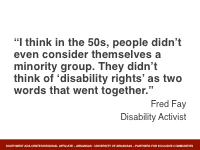
![]() Advance to slide 2
Advance to slide 2
![]() Fred Fay, a disability activist, reflecting on the disability rights movement’s beginnings stated, “I think in the 50s, people didn’t even consider themselves a minority group. They didn’t think of ‘disability rights’ as two words that went together.”
Fred Fay, a disability activist, reflecting on the disability rights movement’s beginnings stated, “I think in the 50s, people didn’t even consider themselves a minority group. They didn’t think of ‘disability rights’ as two words that went together.”
Yet as civil rights movements grew among African Americans and women, disability activists organized a civil rights movement of their own which led to the passage of the Rehabilitation Act of 1973 which included Section 504 where just a few words made a huge difference for people with disabilities. Those words were:
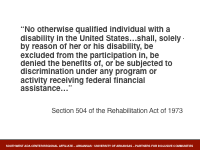
![]() Advance to Slide 3
Advance to Slide 3
![]() “No otherwise qualified individual with a disability in the United States…shall, solely by reason of her or his disability, be excluded from the participation in, be denied the benefits of, or be subjected to discrimination under any program or activity receiving federal financial assistance…”
“No otherwise qualified individual with a disability in the United States…shall, solely by reason of her or his disability, be excluded from the participation in, be denied the benefits of, or be subjected to discrimination under any program or activity receiving federal financial assistance…”
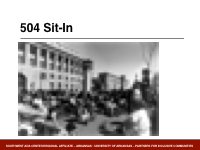
![]() Advance to Slide 4
Advance to Slide 4
![]() But when the signing of the 504 regulations that would enforce this law was delayed, disability activists organized one of the most powerful protests our nation has ever seen—the 504 Sit-In. In response to the protests, a congressional hearing was convened. We’ll watch a few of the testimonies of that hearing.
But when the signing of the 504 regulations that would enforce this law was delayed, disability activists organized one of the most powerful protests our nation has ever seen—the 504 Sit-In. In response to the protests, a congressional hearing was convened. We’ll watch a few of the testimonies of that hearing.
You’ll hear from disability activists, Ed Roberts, Phil Newmark and Judy Heumann.
![]() Play The Power of 504 Video from 2:15 to 4:55.
Play The Power of 504 Video from 2:15 to 4:55.
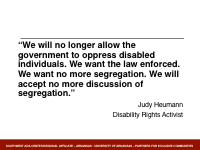
![]() Advance to Slide 5
Advance to Slide 5
![]() I’d like to repeat what Judy Heumann said in the video, “I can tell you that every time you raise issues of ‘separate but equal’ the outrage of disabled individuals across the country is going to continue. It’s going to be ignited.” And then… “We will no longer allow the government to oppress disabled individuals. We want the law enforced. We want no more segregation. We will accept no more discussion of segregation.”
I’d like to repeat what Judy Heumann said in the video, “I can tell you that every time you raise issues of ‘separate but equal’ the outrage of disabled individuals across the country is going to continue. It’s going to be ignited.” And then… “We will no longer allow the government to oppress disabled individuals. We want the law enforced. We want no more segregation. We will accept no more discussion of segregation.”
Building on the civil rights movement of African Americans where Brown v. Board of Education struck down the practice of segregated, so-called “separate but equal” education, the fight for equal access challenged practices of segregation faced by disabled people.
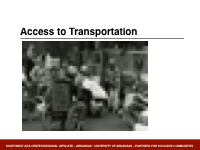
![]() Advance to Slide 6
Advance to Slide 6
![]() The slogan “Access is a Civil Right” emerged during protests in the ’80s where disabled activists blocked city transit because of its inaccessibility. The organizing and relationships established during the ’70s and ’80s laid the groundwork the passage of the Americans with Disabilities Act.
The slogan “Access is a Civil Right” emerged during protests in the ’80s where disabled activists blocked city transit because of its inaccessibility. The organizing and relationships established during the ’70s and ’80s laid the groundwork the passage of the Americans with Disabilities Act.
This video highlights the activities and emotions on day of the signing of the ADA.
![]() Play The Americans with Disabilities Act, Signing Ceremony, July 26, 1990
Play The Americans with Disabilities Act, Signing Ceremony, July 26, 1990
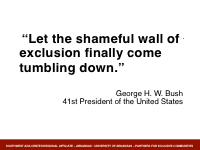
![]() Advance to Slide 7
Advance to Slide 7
![]() The powerful statement of George H. W. Bush, “Let the shameful wall of exclusion finally come tumbling down,” continues to hold power today. We would hope that we could say that that wall came tumbling down on that very day. But did it?
The powerful statement of George H. W. Bush, “Let the shameful wall of exclusion finally come tumbling down,” continues to hold power today. We would hope that we could say that that wall came tumbling down on that very day. But did it?
![]() Pose questions for discussion. Choose questions appropriate for your audience.
Pose questions for discussion. Choose questions appropriate for your audience.
- Do you see examples today of segregation of people with disabilities?
- Do you see attempts at achieving access through a separate but equal approach?
![]() Let’s look at some examples of ways access is provided.
Let’s look at some examples of ways access is provided.
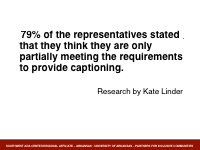
![]() Advance to Slide 8
Advance to Slide 8
In a research project conducted by Kate Linder, 47 postsecondary institutions were surveyed about their captioning practices. 79% of the representatives from those institutions stated that they think they are only partially meeting the requirements to provide captioning.
Source: Implementation of and Solutions for Closed Captioning in U.S. Institutions of Higher Education
Results from a national study
Katie Linder, Ph.D.
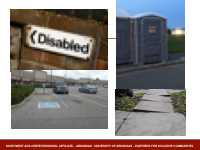
![]() Advance to Slide 9
Advance to Slide 9
This slide shows a series of photos. A sign that shows access to the side of the building. A supposedly accessible portable toilet that’s place on a curb. A broken sidewalk. And a supposedly accessible parking space with no accessible route.
![]() Advance to Slide 10
Advance to Slide 10
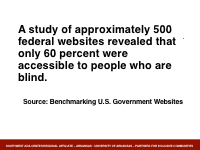 A study of approximately 500 federal websites revealed that only 60 percent were accessible to people who are blind.
A study of approximately 500 federal websites revealed that only 60 percent were accessible to people who are blind.
Source: Benchmarking U.S. Government Websites
These are just a few examples of how we fall short of providing full and equal access.
![]() Pose questions for discussion. Choose questions appropriate for your audience.
Pose questions for discussion. Choose questions appropriate for your audience.
- Can you think of other examples?
- If we embrace access as a civil right, what kinds of things would we stop doing?
- What would we do more of?
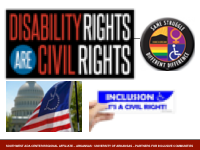
![]() Advance to slide 11
Advance to slide 11
![]() [Describe the images on the slide.]
[Describe the images on the slide.]
As the struggle for full access and civil rights continues, perhaps it is important to ask ourselves what our role is in achieving the vision of access.
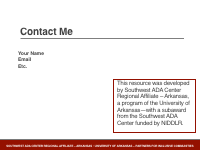
![]() Advance to slide 12
Advance to slide 12
![]() Thank you for joining me in this discussion. I look forward to other opportunities to engage with you about how we as a campus community can continue to move toward the vision of full inclusion and access.Feel free to contact me at [your information]. I’d like to thank the Southwest ADA Center Regional Affiliate of Arkansas, a program of the University of Arkansas Partners for Inclusive Communities for developing the content provided in this presentation.
Thank you for joining me in this discussion. I look forward to other opportunities to engage with you about how we as a campus community can continue to move toward the vision of full inclusion and access.Feel free to contact me at [your information]. I’d like to thank the Southwest ADA Center Regional Affiliate of Arkansas, a program of the University of Arkansas Partners for Inclusive Communities for developing the content provided in this presentation.
